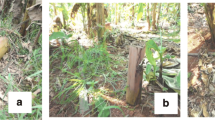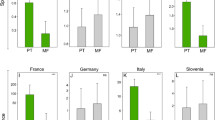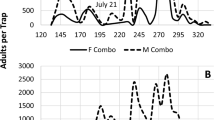Abstract
Dendrolimus pini is one of the most harmful defoliators of Scots pine in Poland and other countries in Europe and Central Asia. The monitoring of this insect needs to be improved and to include the use of pheromone traps. Laboratory studies were conducted to compare changes in the residual amounts of (Z,E)-5,7-dodecadienal and (Z,E)-5,7-dodecadien-1-ol, the major components of the D. pini pheromone, in four types of dispensers. The two most promising dispensers, red rubber cylindrical dispensers (rubber cylinders) and polyethylene vials, were tested in the field for their ability to attract D. pini males. In addition, the effects of trap type (sticky wing, non-sticky cross-vane, bucket, funnel and modified gypsy moth milk carton) and height of trap placement (1.5 m, 5–6 m and tree crown) on trap catches were tested in the field. The vials provided the longest half-lives for both the aldehyde and alcohol under laboratory conditions. These dispensers were also significantly more effective in attracting D. pini males to the traps than the rubber cylinders in the field experiment. The cross-vane and bucket traps were the most effective among the tested traps. The height of trap placement had a significant effect on catches, with more males caught in traps that were hung at 5–6 m above the ground than those hung in the tree crowns. Our results may be useful for developing a monitoring system for D. pini in Europe and other regions where it occurs.





Similar content being viewed by others
References
Álvarez, G., Etxebeste, I., Gallego, D., David, G., Bonifacio, L., Jactel, H., Sousa, E., & Pajares, J. A. (2015). Optimization of traps for live trapping of pine wood nematode vector Monochamus galloprovincialis. Journal of Applied Entomology, 139, 618–626.
Baranchikov, Y. N., Pet’ko, V. M., Ragenovich, A. R., Klun, J. A., & Mastro, V. K. (2004). Pheromone trap for monitoring population density of the siberian moth. Lesnoe Khozyaistvo, 3, 46–47 (in Russian).
Baranchikov, Y.N., Pet’ko, V.M., Ponomarev, V.L. (2007). The Russians are coming - aren’t they? Siberian moth in European forests. In K.W. Gottschalk (Ed.), proceedings, 17th U.S. Department of Agriculture interagency research forum on gypsy moth and other invasive species 2006; gen.Tech.Rep. NRS-P-10. (pp. 18–20). Newtown Square, PA: U.S. Department of Agriculture, Forest Service, Northern Research Station.
Bestmann, H. J., Koschatzky, K. H., Platz, H., Süβ, J., Vostrowsky, O., Knauf, W., Burghardt, G., & Schneider, I. (1982). Pheromone, XL. Stereoselektive Synthese des Pheromonkomplexes von Lasiocampidae-Arten (Lepidoptera); ein Sexuallockstoff für den Kiefernspinner Dendrolimus pini. European Journal of Organic Chemistry, 7, 1359–1365.
Björkman, C., Lindelöw, Å., Eklund, K., Kyrk, S., Klapwijk, M. J., Fedderwitz, F., & Nordlander, G. (2013). A rare event – An isolated outbreak of the pine-tree lappet moth (Dendrolimus pini) in the Stockholm archipelago. Entomologisk Tidskrift, 134, 1–9.
Butler, L. I., & McDonough, L. M. (1979). Insect sex pheromones: Evaporation rates of acetates from natural rubber septa. Journal of Chemical Ecology, 5, 825–637.
Butler, L. I., & McDonough, L. M. (1981). Insect sex pheromones: Evaporation rates of alcohols and acetates from natural rubber septa. Journal of Chemical Ecology, 7, 627–633.
CAPS Approved Methods (2011). Pine-tree Lappet – Dendrolimus pini. Last accessed February 5, 2018, http://pest.ceris.purdue.edu/services/approvedmethods/sheet.php?v=682.
Forest protection guidelines [Instrukcja ochrony lasu] (2012). Centrum Informacyjne Lasów Państwowych, Warszawa.
Fournier, D. A., Skaug, H. J., Ancheta, J., Ianelli, J., Magnusson, A., Maunder, M., Nielsen, A., & Sibert, J. (2012). AD model builder: Using automatic differentiation for statistical inference of highly parameterized complex nonlinear models. Optimization Methods and Software, 27, 233–249.
Graves, S., Piepho, H.-P., Selzer, L. with help from Dorai-Raj, S. (2015). multcompView: Visualizations of Paired Comparisons. R package version 0.1–7.
Gray, T. G., Shepherd, R. F., Struble, D. L., Byers, J. B., & Maher, T. F. (1991). Selection of pheromone trap and attractant dispenser load to monitor black army cutworm, Actebia fennica. Journal of Chemical Ecology, 17, 309–316.
Guerrero, S., Brambila, J., & Meagher, R. (2014). Efficacies of four pheromone-baited traps in capturing male Helicoverpa (Lepidoptera: Noctuidae) moths in northern Florida. Florida Entomologist, 97, 1671–1678.
Hall, D. R., Farman, D., Domínguez, J. C., & Pajares, J. A. (2017). Female sex pheromone of the cone moth, Dioryctria mendacella: Investigation of synergism between type I and type II pheromone components. Journal of Chemical Ecology, 43(5), 433–442.
Harding, S. G., & Gladden, L. F. (1998). Diffusion of liquids into semicrystalline polyethylene. Journal of Magnetic Resonance Imaging, 16, 647–649.
Hasdenteufel, F. (2006). Twenty years of separation of cis-trans (Z)-(E) isomers. Separation and Purification Reviews, 35, 193–221.
Haynes, K. F., McLaughlin, J., Stamper, S., Rucker, C., Webster, F. X., Czokajlo, D., & Kirsch, P. (2007). Pheromone trap for the eastern tent caterpillar moth. Environmental Entomology, 36, 1199–1205.
Jabłoński, T. (2014). Barczatka sosnówka – Dendrolimus pini L. In Krótkoterminowa Prognoza Występowania Ważniejszych Szkodników i Chorób Infekcyjnych Drzew Leśnych w Polsce w 2014 r; Analizy i Raporty 22 (pp. 45–49). Instytut Badawczy Leśnictwa: Sękocin Stary, Poland.
Jactel, H., Menassieu, P., Vétillard, F., Barthélémy, B., Piou, D., Frérot, B., Rousselet, J., Goussard, F., Branco, M., & Battisti, A. (2006). Population monitoring of the pine processionary moth (Lepidoptera: Thaumetopoeidae) with pheromone-baited traps. Forest Ecology and Management, 235, 96–106.
Johansson, B. G., Anderbrant, O., & Sierpinski, A. (2002). Multispecies trapping of six pests of scots pine in Sweden and Poland. Journal of Applied Entomology, 126, 212–216.
Khrimian, A., Klun, J. A., Hijji, J., Baranchikov, J. N., Pet’ko, V. M., Mastro, V. C., & Kramer, M. H. (2002). Syntheses of (Z,E)-5,7-dodecadienol and (E,Z)-10,12-hexadecadienol, lepidoptera pheromone components, via zinc reduction of enyne precursors. test of pheromone efficacy against the Siberian moth. Journal of Agricultural and Food Chemistry, 50, 6366–6370.
Klun, J. A., Baranchikov, Y. N., Mastro, V. C., Hijji, Y., Nicholson, J., Ragenovich, I., & Vshivkova, T. A. (2000). A sex attractant for the Siberian moth Dendrolimus superans sibiricus (Lepidoptera: Lasiocampidae). Journal of Entomological Science, 35, 158–166.
Kong, X., Zhao, C., & Gao, W. (2001). Identification of sex pheromones of four economically important species in genus Dendrolimus. Chinese Science Bulletin, 46, 2077–2081.
Kong, X. B., Zhang, Z., Zhao, C. H., & Wang, H. B. (2007). Female sex pheromone of the Yunnan pine caterpillar moth Dendrolimus houi: first (E,Z)-isomers in pheromone components of Dendrolimus spp. Journal of Chemical Ecology, 33, 1316–1327.
Kong, X.-B., Sun, X.-L., Wang, H.-B., Zhang, Z., Zhao, C.-H., & Booij, K. C. J. H. (2011). Identification of components of the female sex pheromone of the Simao pine caterpillar moth, Dendrolimus kikuchii Matsumara. Journal of Chemical Ecology, 37, 412–419.
Kovalev, B. G., Bolgar, T. S., Zubov, P. A., Zharkov, D. G., Golosova, M., Nesterov, E. A., & Tvaradze, M. S. (1993). Identification of additional components of the sex pheromone of Dendrolimus pini. Chemistry of Natural Compounds, 29, 135–136.
Lance, D. (2006). Guidelines for detection trapping of exotic lymantriid and lasiocampid moths. United States Department of Agriculture.
Laurent, P., & Frérot, B. (2007). Monitoring of European corn borer with pheromone-baited traps: Review of trapping system basics and remaining problems. Journal of Economic Entomology, 100, 1797–1807.
Lenth, R. (2018). Emmeans: Estimated marginal means, aka least-squares means. R package version 1.3.1.
Li, X., Kong, X., Zhang, S., Wang, H., Zhang, Z., & Yang, M. (2015). Researches on the release rates of four types of insect semiochemicals from four dispenser types. Scientia Silvae Sinivae, 51, 63–70.
Makitra, R., Pyrih, Y., Sagladko, E., Turovskiy, A., & Zaikov, G. (2001). Generalization of polymer/organic solvent interaction processes by means of linear polyparameter equation. I. Swelling of polyethylene. Journal of Applied Polymer Science, 81, 3133–3140.
Mangiafico, S.S. (2016). Summary and analysis of extension program evaluation in R, version 1.15.0. rcompanion.org/handbook/. (Pdf version: rcompanion.org/documents/RHandbookProgramEvaluation.pdf).
McDonough, L. M., Brown, D. F., & Aller, W. C. (1989). Insect sex pheromone: Effect of temperature on evaporation rates of acetates from rubber septa. Journal of Chemical Ecology, 15, 779–790.
Moore, R., Cottrell, J., A’Hara, S., & Ray, D. (2017). Pine-tree lappet moth (Dendrolimus pini) in Scotland: Discovery, timber movement controls and assessment of risk. Scottish Forestry, 71, 34–43.
Ostrauskas, H., & Ivinskis, P. (2011). Moths caught in pheromone traps during search for Dendrolimus pini and D. sibiricus (Lepidoptera, Lasiocampidae) in Lithuania. Acta Zoologica Lituanica, 21, 238–243.
Pletnev, V. A., Ponomarev, V. L., Vendilo, N. V., Kurbatov, S. A., & Lebedeva, K. V. (2000). Search of the pheromone of Siberian silkworm Dendrolimus superans sibiricus (Lepidoptera: Lasiocampidae). Agrokhimiya, 6, 67–72.
Ponomarev, B. L., Baranchikov, Y. N., Marchenko, Y. I., & Ostrauskas, H. H. (2006). Field testing of Dendrolimus pini L. sex pheromone. Lesnoy Vestnik, 2, 145–151.
Priesner, E., Bogenschütz, H., Albert, R., Reed, D. W., & Chisholm, M. D. (1984). Identification and field evaluation of a sex pheromone of the European pine moth. Zeitschrift für Naturforschung C, 39, 1192–1195.
R Core Team (2018). R: A language and environment for statistical computing, v. 3.5.1. R Foundation for Statistical Computing, Vienna, Austria.
R Studio Team (2016). RStudio: Integrated development for R, v. 1.1.463. RStudio, Inc., Boston, MA.
Ray, D., Peace, A., Moore, R., Petr, M., Grieve, Y., Convery, C., & Ziesche, T. (2016). Improved prediction of the climate-driven outbreaks of Dendrolimus pini in Pinus sylvestris forests. Forestry, 89, 230–244.
Schmidt, B. C., & Roland, J. (2003). Developing techniques for monitoring forest tent caterpillar populations using synthetic pheromones. Canadian Entomologist, 135, 439–448.
Siegel, S., & Castellan Jr., N. J. (1988). Nonparametric statistics for the behavioral sciences (2nd ed.). New York, NY, England: McGraw-Hill Book Company.
Skaug, H., Fournier, D., Bolker, B., Magnusson, A., Nielsen, A. (2016). Generalized linear mixed models using 'AD model Builder'. R package version 0.8.3.3.
StatSoft Inc. (2011). STATISTICA (data analysis software system), version 10.
Stille, J. K., & Groh, B. L. (1987). Stereospecific cross-coupling of vinyl halides with vinyl tin reagents catalyzed by palladium. Journal of the American Chemical Society, 109, 813–817.
Stille, J. K., & Simpson, J. H. (1987). Stereospecific palladium-catalyzed coupling reactions of vinyl iodides with acetylenic tin reagents. Journal of the American Chemical Society, 109, 2138–2152.
USDA, APHIS, PPQ (2011). New Pest Response Guidelines: Dendrolimus Pine Moths. Washington, D.C. Last accessed September 1, 2019,http://www.aphis.usda.gov/import_export/plants/manuals/online_manuals.shtml.
Venables, W. N., & Ripley, B. D. (2002). Modern applied statistics with S (Fourth ed.). New York: Springer.
Wang, P., Chen, G.-F., Zhang, J.-S., Xue, Q., Zhang, J.-H., Chen, C., & Zhang, Q.-H. (2017). Pheromone-trapping the nun moth, Lymantria monacha (Lepidoptera: Lymantriidae) in Inner Mongolia, China. Insect Sci., 24, 631–639.
Zhang, A.-B., Wang, Z.-J., Tan, S.-J., & Li, D.-M. (2003). Monitoring the masson pine moth, Dendrolimus punctatus (Walker) (Lepidoptera: Lasiocampidae) with synthetic sex pheromone-baited traps in Qianshan County, China. Applied Entomology and Zoology, 38, 177–186.
Zhang, A., Leskey, T. C., Bergh, J. C., & Walgenbach, J. F. (2013). Sex pheromone dispenser type and trap design affect capture of dogwood borer. Journal of Chemical Ecology, 39, 390–397.
Acknowledgements
We would like to thank the staff of the Wolsztyn, Krucz and Człopa forest districts and the staff of the Forest Protection Service Units in Szczecinek and Łopuchówko for their support in the field experiments. We are grateful to two anonymous reviewers and Dr. Alejandro Solla from Extremadura University in Spain for valuable comments that allowed to improve the manuscript. This study was financially supported by the National Centre for Research and Development, Poland (Narodowe Centrum Badań i Rozwoju, Agreement No. PBS2/A9/25/2013).
Author information
Authors and Affiliations
Corresponding author
Ethics declarations
Conflict of interest
The authors declare that they have no conflict of interest.
Ethical approval
This article does not contain any studies performed with human participants or animals by any of the authors.
Additional information
Publisher’s note
Springer Nature remains neutral with regard to jurisdictional claims in published maps and institutional affiliations.
Rights and permissions
About this article
Cite this article
Sukovata, L., Asztemborska, M., Rudziński, K.J. et al. Effect of dispenser type, trap design and placement on catches of pine-tree lappet moth, Dendrolimus pini. Phytoparasitica 48, 63–74 (2020). https://doi.org/10.1007/s12600-019-00772-9
Received:
Accepted:
Published:
Issue Date:
DOI: https://doi.org/10.1007/s12600-019-00772-9




